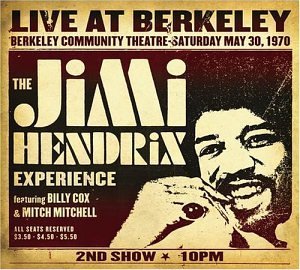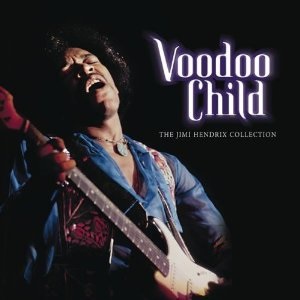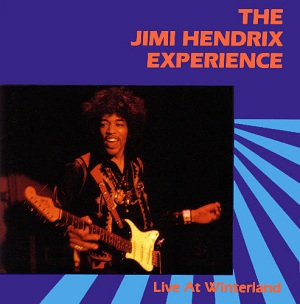
Electric Ladyland is the third and final studio album by the Jimi Hendrix Experience, released in October 1968. A double album, it was the only record from the Experience with production solely credited to Hendrix. The band's most commercially successful release and its only number one album, it was released by Reprise Records in the United States on October 16, 1968, and by Track Records in the UK nine days later. By mid-November, it had reached number 1 on the Billboard Top LPs chart, spending two weeks there. In the UK it peaked at number 6, where it spent 12 weeks on the British charts.

Axis: Bold as Love is the second studio album by the Jimi Hendrix Experience. It was first released by Track Records in the United Kingdom on December 1, 1967, only seven months after the release of the group's highly successful debut album, Are You Experienced. In the United States, Reprise Records delayed the release until the following month. The album reached the top ten in the album charts in both countries.

Band of Gypsys is a live album by Jimi Hendrix and the first without his original group, the Jimi Hendrix Experience. It was recorded on January 1, 1970, at the Fillmore East in New York City with Billy Cox on bass and Buddy Miles on drums, frequently referred to as the Band of Gypsys. The album mixes funk and rhythm and blues elements with hard rock and jamming, an approach which later became the basis of funk rock. It contains previously unreleased songs and was the last full-length Hendrix album released before his death six months later.

First Rays of the New Rising Sun is a compilation album credited to American rock musician Jimi Hendrix, issued in April 1997 on MCA Records. Featuring songs mostly intended for his planned fourth studio album, it was one of the first releases overseen by Experience Hendrix, the family company that took over management of his recording legacy. It reached the album charts in the United States, United Kingdom, and four other countries.

Blues is a compilation album of blues songs recorded by American singer/songwriter/musician Jimi Hendrix. Compiled by interim Hendrix producer Alan Douglas, it was released April 26, 1994, by MCA Records. The album contains eleven songs recorded by Hendrix between 1966 and 1970, six of which were previously unreleased. Hendrix wrote seven of the pieces; other writers include Muddy Waters, Booker T. Jones, and Elmore James. Most are demos, jams, and live recordings, which Hendrix may or may not have completed for release.
"Red House" is a song written by Jimi Hendrix and one of the first songs recorded in 1966 by the Jimi Hendrix Experience. It has the musical form of a conventional twelve-bar blues and features Hendrix's guitar playing. He developed the song prior to forming the Experience and was inspired by earlier blues songs.

Woodstock Two is the second live album released of the 1969 Woodstock Festival concert. The two-LP set contains more material from many acts featured on the first Woodstock album with additional performances from Mountain and Melanie. The tracks by Mountain were in fact not from their Woodstock performance but rather a show recorded at New York's Fillmore East. Unlike the first Woodstock soundtrack LP, this LP does not contain any ancillary stage announcements. Like the previous album this was also packaged in a triple gatefold sleeve.

Live at Woodstock is a posthumous live album by Jimi Hendrix released on July 6, 1999. It documents most of his performance at the Woodstock Festival on August 18, 1969, and contains Hendrix's iconic interpretation of "The Star-Spangled Banner" and other songs from the original festival film and soundtrack album.

South Saturn Delta is a posthumous compilation album by American rock musician Jimi Hendrix. Released in 1997 by Experience Hendrix, it consists of material such as demo tapes, unfinished takes and alternate mixes, and previously released material, most of which Hendrix had been working on prior to his death in 1970.

Live at Berkeley is a live album by American rock musician Jimi Hendrix. It documents his second performance at the Berkeley Community Theatre on May 30, 1970, and was released by MCA Records on September 16, 2003.

Voodoo Child: The Jimi Hendrix Collection is a two-disc compilation album featuring songs recorded by American rock singer-songwriter and guitarist Jimi Hendrix. It was released on May 8, 2001 by MCA Records. The first disc contains studio recordings, including alternate versions, while the second disc contains live recordings, some of which were previously unreleased. Its accompanying booklet features numerous photos and an essay written by Kurt Loder.

Historic Performances Recorded at the Monterey International Pop Festival is a live album recorded at the Monterey Pop Festival in June 1967. A split artist release, it includes some of the performances by the Jimi Hendrix Experience on side one and Otis Redding on side two. It has been supplanted by later more comprehensive releases, Live at Monterey and Captured Live at the Monterey International Pop Festival .

Nine to the Universe is a posthumous compilation album by American guitarist Jimi Hendrix. It was released in March 1980 in the US and in June 1980 in the UK. It was the third album of Hendrix recordings to be produced by Alan Douglas.

In Concert is a live double album by American jazz musician Miles Davis. It was recorded in 1972 at the Philharmonic Hall in New York City. Columbia Records' original release did not credit any personnel, recording date, or track listing, apart from the inner liner listing the two titles "Foot Fooler" and "Slickaphonics."

Rainbow Bridge is a compilation album by American rock musician Jimi Hendrix. It was the second posthumous album release by his official record company and is mostly composed of recordings Hendrix made in 1969 and 1970 after the breakup of the Jimi Hendrix Experience. Despite the cover photo and subtitle Original Motion Picture Sound Track, it does not contain any songs recorded during his concert appearance for the 1971 film Rainbow Bridge.

Johnny B. Goode is a live album by Jimi Hendrix, released posthumously in June 1986. It contains three songs from Hendrix's performance at the 1970 Atlanta International Pop Festival on July 4, 1970, and two songs, including the title track, from a performance at the Berkeley Community Theater on May 30, 1970.

Band of Gypsys 2 is a posthumous live album by American rock musician Jimi Hendrix, released in October 1986 by Capitol Records. Produced by Alan Douglas, it followed the live mini LP Johnny B. Goode (1986), which also included live recordings from the Atlanta International Pop Festival (1970) and the Berkeley Community Theatre (1970).

Live at Winterland is a live album by The Jimi Hendrix Experience. It compiles performances from the band's three concerts at the Winterland Ballroom in San Francisco, where they played two shows each night on October 10, 11 and 12, 1968. The album was released posthumously by Rykodisc in 1987 and was the first Hendrix release to be specifically conceived for the compact disc format.

Radio One is a live album by The Jimi Hendrix Experience. It was released posthumously in November 1988 by Rykodisc and compiles tracks recorded between February and December 1967 for broadcasts by BBC Radio. The album peaked at number 30 on the UK Albums Chart while it charted at number 119 on the Billboard 200 in the United States. After Hendrix's family gained control of his legacy, Radio One was supplanted by the more comprehensive BBC Sessions in 1998.

"Hear My Train A Comin'" is a blues-based song written by Jimi Hendrix. Lyrically, it was inspired by earlier American spirituals and blues songs which use a train metaphor to represent salvation. Hendrix recorded the song in live, studio, and impromptu settings several times between 1967 and 1970, but never completed it to his satisfaction.

















